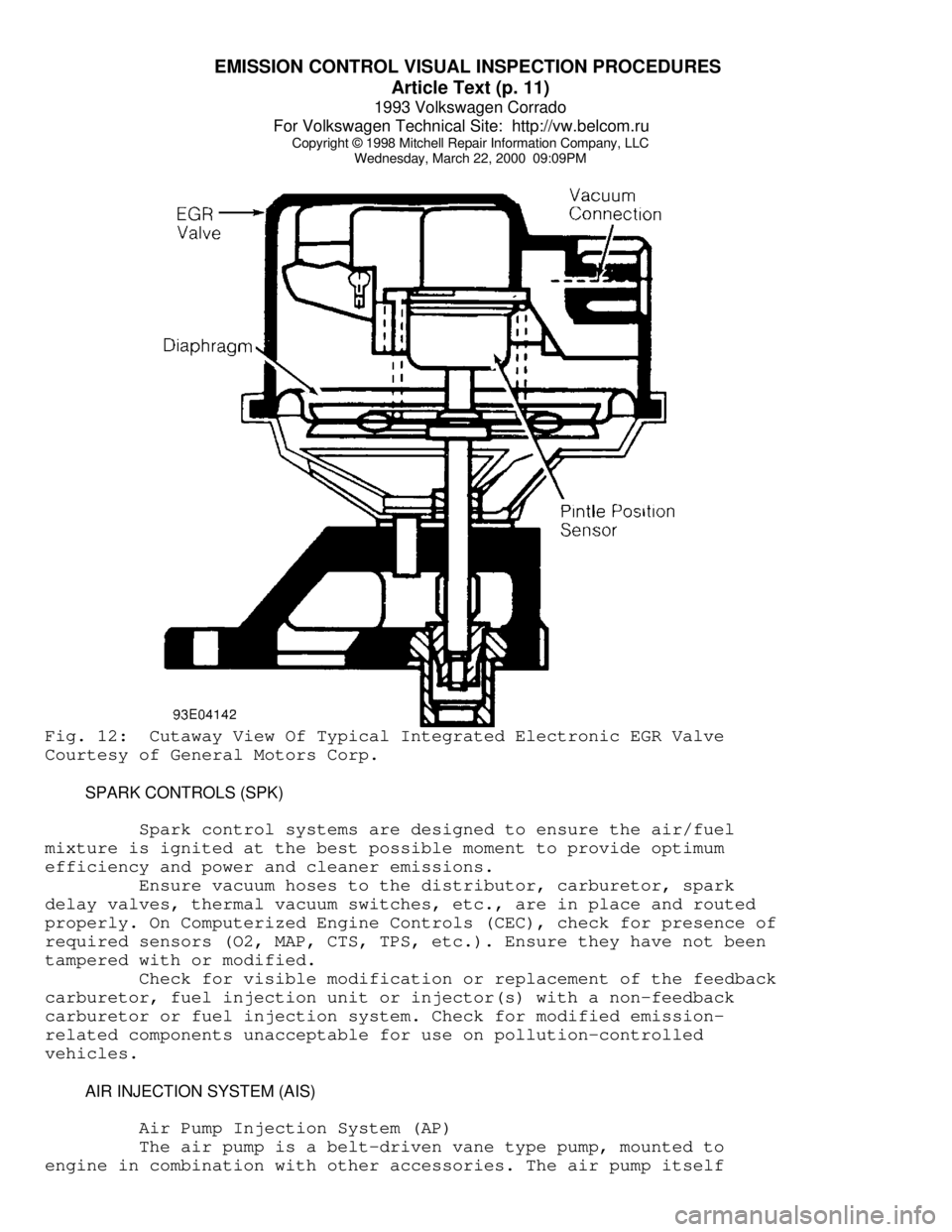1993 VOLKSWAGEN CORRADO sensor
[x] Cancel search: sensorPage 525 of 920

EMISSION CONTROL VISUAL INSPECTION PROCEDURES
Article Text (p. 11)
1993 Volkswagen Corrado
For Volkswagen Technical Site: http://vw.belcom.ru
Copyright © 1998 Mitchell Repair Information Company, LLC
Wednesday, March 22, 2000 09:09PMFig. 12: Cutaway View Of Typical Integrated Electronic EGR Valve
Courtesy of General Motors Corp.
SPARK CONTROLS (SPK)
Spark control systems are designed to ensure the air/fuel
mixture is ignited at the best possible moment to provide optimum
efficiency and power and cleaner emissions.
Ensure vacuum hoses to the distributor, carburetor, spark
delay valves, thermal vacuum switches, etc., are in place and routed
properly. On Computerized Engine Controls (CEC), check for presence of
required sensors (O2, MAP, CTS, TPS, etc.). Ensure they have not been
tampered with or modified.
Check for visible modification or replacement of the feedback
carburetor, fuel injection unit or injector(s) with a non-feedback
carburetor or fuel injection system. Check for modified emission-
related components unacceptable for use on pollution-controlled
vehicles.
AIR INJECTION SYSTEM (AIS)
Air Pump Injection System (AP)
The air pump is a belt-driven vane type pump, mounted to
engine in combination with other accessories. The air pump itself
Page 527 of 920

EMISSION CONTROL VISUAL INSPECTION PROCEDURES
Article Text (p. 13)
1993 Volkswagen Corrado
For Volkswagen Technical Site: http://vw.belcom.ru
Copyright © 1998 Mitchell Repair Information Company, LLC
Wednesday, March 22, 2000 09:09PM
OXYGEN SENSOR (O2)
The O2 sensor is mounted in the exhaust system where it
monitors oxygen content of exhaust gases. Some vehicles may use 2 O2
sensors. The O2 sensor produces a voltage signal which is proportional
to exhaust gas oxygen concentration (0-3%) compared to outside oxygen
(20-21%). This voltage signal is low (about .1 volt) when a lean
mixture is present and high (1.0 volt) when a rich mixture is present.
As ECM compensates for a lean or rich condition, this
voltage signal constantly fluctuates between high and low, crossing a
reference voltage supplied by the ECM on the O2 signal line. This is
referred to as cross counts. A problem in the O2 sensor circuit should
set a related trouble code.
COMPUTERIZED ENGINE CONTROLS (CEC)
The CEC system monitors and controls a variety of
engine/vehicle functions. The CEC system is primarily an emission
control system designed to maintain a 14.7:1 air/fuel ratio under most
operating conditions. When the ideal air/fuel ratio is maintained, the
catalytic converter can control oxides of nitrogen (NOx), hydrocarbon
(HC) and carbon monoxide (CO) emissions.
The CEC system consists of the following sub-systems:
Electronic Control Module (ECM), input devices (sensors and switches)
and output signals.
EARLY FUEL EVAPORATION (EFE)
The EFE valve is actuated by either a vacuum actuator or a
bimetal spring (heat-riser type). The EFE valve is closed when engine
is cold. The closed valve restricts exhaust gas flow from the exhaust
manifold. This forces part of the exhaust gas to flow up through a
passage below the carburetor. As the exhaust gas quickly warms the
intake mixture, distribution is improved. This results in better cold
engine driveability, shorter choke periods and lower emissions.
Ensure EFE valve in exhaust manifold is not frozen or rusted
in a fixed position. On vacuum-actuated EFE system, check EFE thermal
vacuum valve and check valve(s). Also check for proper vacuum hose
routing. See Fig. 15.
Page 567 of 920

F - BASIC TESTING
Article Text (p. 2)
1993 Volkswagen Corrado
For Volkswagen Technical Site: http://vw.belcom.ru
Copyright © 1998 Mitchell Repair Information Company, LLC
Wednesday, March 22, 2000 09:10PMÄÄÄÄÄÄÄÄÄÄÄÄÄÄÄÄÄÄÄÄÄÄÄÄÄÄÄÄÄÄÄÄÄÄÄÄÄÄÄÄÄÄÄÄÄÄÄÄÄÄÄÄÄÄÄÄÄÄÄÄÄÄÄÄÄ Compression
Pressure Compression
Application psi (kg/cm
ý) Ratio
Cabriolet ............. 131-174 (9.2-12.2) ........... 10.0:1
Corrado SLC ........... 157-186 (11.0-13.0) .......... 10.0:1
EuroVan ............... 128-170 (9.0-12.0) ........... 8.5:1
Fox ................... 128-170 (9.0-12.0) ............ 9.0:1
Golf & GTI ............ 142-186 (10.0-13.0) .......... 10.0:1
Jetta ................. 142-186 (10.0-13.0) .......... 10.0:1
Passat GL (2.0L) ...... 142-186 (10.0-13.0) .......... 10.8:1
Passat GLX (2.8L) ..... 142-186 (10.0-13.0) .......... 10.0:1
ÄÄÄÄÄÄÄÄÄÄÄÄÄÄÄÄÄÄÄÄÄÄÄÄÄÄÄÄÄÄÄÄÄÄÄÄÄÄÄÄÄÄÄÄÄÄÄÄÄÄÄÄÄÄÄÄÄÄÄÄÄÄÄÄÄ Exhaust System Backpressure
The exhaust system can be checked with a vacuum or pressure
gauge. Remove O2 sensor or air injection check valve (if equipped).
Connect a 0-5 psi pressure gauge and operate engine at 2500 RPM. If
exhaust system backpressure is greater than 2 psi, exhaust system or
catalytic converter is plugged.
If a vacuum gauge is used, connect vacuum gauge hose to
intake manifold vacuum port and start engine. Observe vacuum gauge.
Open throttle part way and hold steady. If vacuum gauge reading slowly
drops after stabilizing, check exhaust system for restriction.
FUEL SYSTEM
FUEL SYSTEM APPLICATION
FUEL SYSTEM APPLICATION TABLE
ÚÄÄÄÄÄÄÄÄÄÄÄÄÄÂÄÄÄÄÄÄÄÄÄÂÄÄÄÄÄÄÂÄÄÄÄÄÄÄÄÄÄÄÄÄÄÄÄÄ¿
³
³ ³Engine³ ³
³ Model
³ Engine ³ ID ³ Fuel System ³
ÃÄÄÄÄÄÄÄÄÄÄÄÄÄÅÄÄÄÄÄÄÄÄÄÅÄÄÄÄÄÄÅÄÄÄÄÄÄÄÄÄÄÄÄÄÄÄÄÄ´
³ Cabriolet
³ 1.8L ³ 2H ³ Digifant II MFI ³
³
³ 8-Valve ³ ³ (1) ³
ÃÄÄÄÄÄÄÄÄÄÄÄÄÄÅÄÄÄÄÄÄÄÄÄÅÄÄÄÄÄÄÅÄÄÄÄÄÄÄÄÄÄÄÄÄÄÄÄÄ´
³ Corrado SLC
³ 2.8L VR6³ AAA ³ Motronic MFI (2)³
ÃÄÄÄÄÄÄÄÄÄÄÄÄÄÅÄÄÄÄÄÄÄÄÄÅÄÄÄÄÄÄÅÄÄÄÄÄÄÄÄÄÄÄÄÄÄÄÄÄ´
³ EuroVan
³ 2.5L ³ AAF ³ Digifant MFI ³
³
³10-Valve ³ ³ ³
ÃÄÄÄÄÄÄÄÄÄÄÄÄÄÅÄÄÄÄÄÄÄÄÄÅÄÄÄÄÄÄÅÄÄÄÄÄÄÄÄÄÄÄÄÄÄÄÄÄ´
³ Fox
³ 1.8L ³ ABG ³ Digifant II MFI ³
³
³ 8-Valve ³ ³ (1) ³
ÃÄÄÄÄÄÄÄÄÄÄÄÄÄÅÄÄÄÄÄÄÄÄÄÅÄÄÄÄÄÄÅÄÄÄÄÄÄÄÄÄÄÄÄÄÄÄÄÄ´
³ Golf
³ 2.0L ³ ABA ³ Motronic MFI (2)³
³
³ 8-Valve ³ ³ ³
ÃÄÄÄÄÄÄÄÄÄÄÄÄÄÅÄÄÄÄÄÄÄÄÄÅÄÄÄÄÄÄÅÄÄÄÄÄÄÄÄÄÄÄÄÄÄÄÄÄ´
³ GTI
³ 2.0L ³ ABA ³ Motronic MFI (2)³
³
³ 8-Valve ³ ³ ³
ÃÄÄÄÄÄÄÄÄÄÄÄÄÄÅÄÄÄÄÄÄÄÄÄÅÄÄÄÄÄÄÅÄÄÄÄÄÄÄÄÄÄÄÄÄÄÄÄÄ´
Page 568 of 920

F - BASIC TESTING
Article Text (p. 3)
1993 Volkswagen Corrado
For Volkswagen Technical Site: http://vw.belcom.ru
Copyright © 1998 Mitchell Repair Information Company, LLC
Wednesday, March 22, 2000 09:10PM³ Jetta ³ 2.0L ³ ABA ³ Motronic MFI (2)³
³
³ 8-Valve ³ ³ ³
ÃÄÄÄÄÄÄÄÄÄÄÄÄÄÅÄÄÄÄÄÄÄÄÄÅÄÄÄÄÄÄÅÄÄÄÄÄÄÄÄÄÄÄÄÄÄÄÄÄ´
³ Passat GL
³ 2.0L ³ 9A ³ CIS-E Motronic ³
³
³16-Valve ³ ³ MFI (2) ³
ÃÄÄÄÄÄÄÄÄÄÄÄÄÄÅÄÄÄÄÄÄÄÄÄÅÄÄÄÄÄÄÅÄÄÄÄÄÄÄÄÄÄÄÄÄÄÄÄÄ´
³ Passat GLX
³ 2.8L VR6³ AAA ³ Motronic MFI (2)³
ÃÄÄÄÄÄÄÄÄÄÄÄÄÄÁÄÄÄÄÄÄÄÄÄÁÄÄÄÄÄÄÁÄÄÄÄÄÄÄÄÄÄÄÄÄÄÄÄÄ´
³(1) - California vehicles are equipped with
³
³ Digifant I.
³
³(2) - Sequential Multiport Fuel Injection.
³
ÀÄÄÄÄÄÄÄÄÄÄÄÄÄÄÄÄÄÄÄÄÄÄÄÄÄÄÄÄÄÄÄÄÄÄÄÄÄÄÄÄÄÄÄÄÄÄÄÄÙ FUEL PRESSURE
Basic diagnosis of fuel system should begin with determining
fuel system pressure.
WARNING: ALWAYS relieve fuel pressure before disconnecting any fuel
injection-related component. DO NOT allow fuel to contact
engine or electrical components.
CIS-E Motronic
1) Ensure ignition is off. Wrap a cloth around fuel
distributor port near cold start valve. Slowly loosen distributor port
near cold start valve to release fuel pressure. Connect fuel pressure
gauge between fuel distributor port and end of fuel line to cold start
valve. Disconnect differential pressure regulator harness connector.
2) Start engine and let it run. System fuel pressure should
89-96 psi (6.3-6.7 kg/cm
ý). If system fuel pressure is lower than
specification, perform fuel volume check. If fuel volume is okay,
replace fuel pressure regulator.
3) If fuel pressure is greater than specification, remove
return hose from pressure regulator and place in a container. Repeat
test. If system pressure is okay, check for restricted fuel return
line. If pressure is incorrect, replace fuel pressure regulator.
4) Turn ignition off. After 10 minutes, residual pressure
should be 48 psi (3.4 kg/cm
ý). After 20 minutes, residual pressure
should be 46 psi (3.2 kg/cm
ý). If system fuel pressure is low, check
fuel pump check valve, sensor plate free play, fuel distributor "O"
rings and seats. Replace if necessary. If these components are okay,
replace fuel pressure regulator.
Digifant
1) Ensure ignition is off. Wrap a cloth around service port
on fuel plenum. Slowly loosen service port on fuel plenum to release
fuel pressure. Install fuel pressure gauge at service port on fuel
plenum. Fuel pressure gauge must have reading range of 0-50 psi. Start
engine and allow it to idle. System fuel pressure should be
approximately 36 psi (2.5 kg/cm
ý).
2) Disconnect vacuum hose from top of fuel pressure
regulator. Fuel pressure should increase to approximately 44 psi (3
Page 575 of 920

F - BASIC TESTING
Article Text (p. 10)
1993 Volkswagen Corrado
For Volkswagen Technical Site: http://vw.belcom.ru
Copyright © 1998 Mitchell Repair Information Company, LLC
Wednesday, March 22, 2000 09:10PM
to specification. If necessary, see the appropriate D - ADJUSTMENTS
article in this section. Refer to the following menu:
NOTE: For the appropriate D - ADJUSTMENTS article, go to:
* For Cabriolet, see: D - ADJUSTMENTS
* For Corrado SLC, see: D - ADJUSTMENTS
* For EuroVan, see: D - ADJUSTMENTS
* For Fox, see: D - ADJUSTMENTS
* For Golf, GTI, Jetta, see: D - ADJUSTMENTS
* For Passat GL 2.0L 4-Cylinder, see: D - ADJUSTMENTS - 4-CYL
* For Passat GLX 2.8L VR6, see: D - ADJUSTMENTS - VR6
IDLE SPEED & CO LEVELÄÄÄÄÄÄÄÄÄÄÄÄÄÄÄÄÄÄÄÄÄÄÄÄÄÄÄÄÄÄÄÄÄÄÄÄÄÄÄÄÄÄÄÄÄÄÄÄÄÄÄÄÄÄÄApplication Idle RPM CO Level %
Cabriolet (1)
Digifant I ............. 750-850 ......... 0.3-1.2
Digifant II ............ 750-850 ......... 0.3-1.1
Corrado SLC (2) ......... 650-750 ......... 0.3-1.5
Fox ................... (3) 875-925 ....... 0.3-1.2
Golf, Jetta & GTI (2)
800-880
0.3-1.2
Passat GL ............ (4) 800-1000 ....... 0.2-1.2
Passat GLX (2) .......... 650-750 ......... 0.3-1.5
(1) - With engine running, after reconnecting Blue coolant
temperature sensor. See the D - ADJUSTMENTS article
in this section for more information. See menu above.
(2) - Idle speed and fuel mixture (CO level) are not
adjustable.
(3) - If A/C equipped, disconnect idle speed boost valve
harness connector when checking idle speed. Clamp
crankcase breather hose near emission control valve
when checking CO level.
(4) - Idle speed is not adjustable.
ÄÄÄÄÄÄÄÄÄÄÄÄÄÄÄÄÄÄÄÄÄÄÄÄÄÄÄÄÄÄÄÄÄÄÄÄÄÄÄÄÄÄÄÄÄÄÄÄÄÄÄÄÄÄÄIGNITION TIMING (Degrees BTDC @ RPM)
ÄÄÄÄÄÄÄÄÄÄÄÄÄÄÄÄÄÄÄÄÄÄÄÄÄÄÄÄÄÄÄÄÄÄÄÄÄÄÄÄÄÄÄÄÄÄÄÄÄÄÄÄÄÄÄÄÄÄÄÄApplication Checking Adjusting
Cabriolet (1) ....... 4-8 @ 2000-2500 .. 5-7 @ 2000-2500
Corrado SLC ............... (2) .................... (2)
Fox (1) ............. 4-8 @ 2000-2500 .. 5-7 @ 2000-2500
Golf, GTI & Jetta ... (3) 12 @ 800-880 ............ .....
Passat GL ........... 4-8 @ 800-1000 .... 5-7 @ 800-1000
Passat GLX ................ (2) .................... (2)
(1) - On Digifant I systems, ensure engine oil temperature
Page 576 of 920

F - BASIC TESTING
Article Text (p. 11)
1993 Volkswagen Corrado
For Volkswagen Technical Site: http://vw.belcom.ru
Copyright © 1998 Mitchell Repair Information Company, LLC
Wednesday, March 22, 2000 09:10PM
is 176øF (80øC) and Blue engine coolant temperature
sensor is disconnected.
(2) - Ignition timing is computer controlled. Information
is not available from manufacturer.
(3) - Using Scan Tester (VAG 1551) in START BASIC SETTING
mode. Ignition timing is not adjustable.
ÄÄÄÄÄÄÄÄÄÄÄÄÄÄÄÄÄÄÄÄÄÄÄÄÄÄÄÄÄÄÄÄÄÄÄÄÄÄÄÄÄÄÄÄÄÄÄÄÄÄÄÄÄÄÄÄÄÄÄÄIGNITION TIMING ADVANCE (Degrees BTDC @ RPM)
ÄÄÄÄÄÄÄÄÄÄÄÄÄÄÄÄÄÄÄÄÄÄÄÄÄÄÄÄÄÄÄÄÄÄÄÄÄÄÄÄÄÄÄÄÄÄÄÄÄÄÄÄÄÄÄApplication Specification
Cabriolet
Digifant I (California) .......... (1) 27-33 @ 4500
Digifant II (Other 49 States) .... (1) 20-30 @ 2300
Fox
Digifant I (California) .......... (1) 27-33 @ 4500
Digifant II (Other 49 States) .... (1) 20-30 @ 2300
All Other Models ................................ (2)
(1) - With Blue engine coolant temperature sensor
connected. Specification is in addition to the
initial setting.
(2) - Ignition timing advance is computer controlled.
Information is not available from manufacturer.
ÄÄÄÄÄÄÄÄÄÄÄÄÄÄÄÄÄÄÄÄÄÄÄÄÄÄÄÄÄÄÄÄÄÄÄÄÄÄÄÄÄÄÄÄÄÄÄÄÄÄÄÄÄÄÄ SUMMARY
If no faults were found while performing the tests in this
article, see H - TESTS W/O CODES article in this section for diagnosis
by symptom (i.e., ROUGH IDLE, NO START, etc.) or intermittent
diagnostic procedures.
END OF ARTICLE
Page 580 of 920

FUSES & CIRCUIT BREAKERS
Article Text (p. 2)
1993 Volkswagen Corrado
For Volkswagen Technical Site: http://vw.belcom.ru
Copyright © 1998 Mitchell Repair Information Company, LLC
Wednesday, March 22, 2000 09:11PM
Right Tail & Side Lights
8 - 10 Amp
Left Tail & Side Lights
9 - 20 Amp
Rear Window & Mirror Heating
10 - 15 Amp
Foglights
11 - 10 Amp
Left High Beam, High Beam Indicator
12 - 10 Amp
Right High Beam
13 - 10 Amp
Horn, Radiator Fan
14 - 15 Amp
Back-Up Lights, Electric Mirrors, Heated Windshield Washer
Jets
15 - 10 Amp
Engine Electronic
16 - 15 Amp
Warning/Indicator Lights, Multi-Function Indicator, Glove Box
Light, Cassette Storage Light, Rear Spoiler
17 - 10 Amp
Turn Signals
18 - 20 Amp
Fuel Pump, Oxygen Sensor
19 - 30 Amp
Radiator Fan, Air Conditioner
20 - 10 Amp
Brakelights, Cruise Control
21 - 15 Amp
Dome & Luggage Compartment Lights, Cigarette Lighter, Central
Locking System, Multi-Function Indicator
22 - 10 Amp
Radio
CAUTIONS & WARNINGS
ELECTRICAL SHOCK
WARNING: Contact with live components of ignition system while
engine is running could lead to a fatal electric shock.
RADIATOR FAN
Keep hands away from radiator fan. Fan is controlled by a
thermostatic switch which may come on or run for up to 15 minutes even
after engine is turned off.
RADIATOR CAP
CAUTION: Always disconnect the fan motor when working near the
radiator fan. The fan is temperature controlled and could
Page 583 of 920

G - TESTS W/CODES
Article Text
1993 Volkswagen Corrado
For Volkswagen Technical Site: http://vw.belcom.ru
Copyright © 1998 Mitchell Repair Information Company, LLC
Wednesday, March 22, 2000 09:11PM
ARTICLE BEGINNING
1993 ENGINE PERFORMANCE
Volkswagen Self-Diagnostics
Corrado SLC
INTRODUCTION
If no faults were found while performing preliminary
inspection procedures, proceed with self-diagnostics. If no fault
codes or only pass codes are present after entering self-diagnostics,
proceed to H - TESTS W/O CODES article for diagnosis by symptom (i.e.,
ROUGH IDLE, NO START, etc.).
NOTE: Scan Tester (VAG 1551) must be used to make full use of the
self-diagnostic system capabilities.
SELF-DIAGNOSTIC SYSTEM DESCRIPTION
Hard Failures
Hard failures of monitored sensors and/or components, cause
Malfunction Indicator Light (MIL) to come on and remain on until
problem is repaired. If malfunction indicator CHECK ENGINE light comes
on and remains on during vehicle operation, cause of malfunction must
be determined.
If malfunctions are present for more than 5 seconds, they are
stored as Diagnostic Trouble Codes (DTCs) and will be displayed as a
permanent malfunction even though the malfunction is not occurring at
the time DTCs are displayed. Malfunctions that affect oxygen sensor
control can only be read accurately after a test drive of at least 5
minutes.
Intermittent Failures
If a malfunction occurs for a maximum of 5 seconds, they are
stored and considered to be "sporadic" (intermittent failures). When
displayed on scan tester, malfunctions will have "SP" (sporadic) code.
RETRIEVING CODES
NOTE: See ENTERING SELF-DIAGNOSTICS for additional scan tester
operating instructions.
Corrado SLC
1) Turn ignition on. Connect Jumper Cable (357 971 514E) to
Data Link Connectors (DLC) located in center console. See Fig. 1.
Black end of jumper cable attaches to Black data link connector; White
end of cable attaches to White connector.
2) Leave jumper cable attached for 5 seconds, until on-board
diagnostic CHECK ENGINE light begins to blink. Remove jumper cable.
Allow on-board diagnostic code retrieval procedure to run until Code